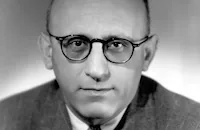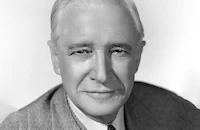This melodrama has been described as Hitchcockian, but don’t confuse it with Alfred Hitchcock’s 1955 black comedy The Trouble with Harry, similar in name and equally caught up in small-town murder. This adaptation of “the play that shocked Broadway” (the picture’s advertising tagline) is less a suspense drama than a story of family dysfunction and obsession. It might be overlooked today if noir master Robert Siodmak hadn’t directed it.
Harry is the last male in a once-prominent family who’s forced by economic circumstances to work as a fabric pattern designer in a Massachusetts textile factory. His dull, lonely, rather repressed life with his two sisters – one a widow, the younger one never wed – is suddenly given a spark by the arrival of a glamorous co-worker from the company’s New York office. Love blossoms (rather inexplicably), but what will Harry do about those pesky, dependent sisters at home? Although he’s doted on and fussed over by both, it’s the younger one, Lettie, who more and more exhibits an unhealthy attachment to Harry and threatens to derail his romance. It’s no great spoiler to recall Chekhov’s dictum not to introduce a gun (or in this case, a vial of poison) in Act I if no one uses it in Act II.
Even with Siodmak’s name and expressionistic style attached, the film rarely comes up in discussions of his work. After leaving behind a promising career in Germany, the Jewish director eventually made his way to Universal Pictures, where he was able to hone his considerable skills in turning out dark, atmospheric thrillers that worked much better than they should have on their relatively low budgets. Uncle Harry is the last in a line that included Phantom Lady (1944), Christmas Holiday (1944) and The Suspect (1944) before Siodmak moved up to the directorial A list with the film noir classics that made his reputation, among them The Spiral Staircase (1946), The Killers (1946), Criss Cross (1949) and The File on Thelma Jordan (1949).
Probably the greatest blow to this picture’s reputation is the tacked-on ending that negates anything of quality that came before. The picture closes with a title card urging audiences not to spoil the experience for others by revealing the final scene, but it’s hard to imagine anyone staying quiet about the laughable “twist,” if only to warn their friends. Nervous about censorship, the studio reversed the morally ambiguous finale of the source material, Thomas Job’s 1942 stage success Uncle Harry, crafting instead one of the most ludicrous happy endings ever committed to celluloid. Really, it must be seen to be believed, and no one would blame you if you have to rewind a few times to make sure of what you just watched.
It’s a shame, really, because George Sanders, as the milquetoast-turned-murderer, gives one of his best performances here. More vulnerable, touching and awkward than his usual suave, cynical screen image, Sanders only allows glimpses of his more sinister side as Harry begins to hatch the plot that will free him from his oppressive, petit bourgeois existence. He’s ably supported by Geraldine Fitzgerald as the manipulative “invalid” sister, Moyna Macgill as the irritatingly chipper supportive one, Sara Allgood as the grumpy but kind-hearted servant and frequent Siodmak actor Ella Raines as Harry’s love interest, signaling her big city sophistication with some breezy banter and a nearly gender-bending fashion sense that starkly contrasts with the lacy primness of the small-town setting.
Back to those Hitchcock references: There’s more of a connection here than superficial resemblances to The Trouble with Harry or Shadow of a Doubt (1943), another story of small-town life turned upside down by a murderous uncle. The picture was produced by Joan Harrison, Hitchcock’s former secretary-assistant and an Oscar-nominee for her screenwriting (with collaborators) on his Rebecca (1940) and Foreign Correspondent (1940). She also co-wrote the Hitchcock films Jamaica Inn (1939), Suspicion (1941) and Saboteur (1942) and produced his 1950s-60s TV series Alfred Hitchcock Presents.
And then there’s the Strange Affair of Geraldine Fitzgerald, the Irish-born actor hailed as a major talent and a star on the rise after supporting work in her Hollywood debut Wuthering Heights (1939), for which she was Oscar-nominated, and Dark Victory (1939). But according to James Agee in his 1945 review of the Siodmak film, she blew it by being too – gasp! – independent, turning down the lead in a major production because she wanted to spend time in Ireland with her husband, do more stage work and not be under contract to David O. Selznick. The potentially star-making part she refused? Alfred Hitchcock’s Rebecca.
Director: Robert Siodmak
Executive Producer: Charles K. Feldman
Screenplay: Stephen Longstreet, adapted by Keith Winter from the play Uncle Harry by Thomas Job
Cinematography: Paul Ivano
Editing: Arthur Hilton
Art Direction: John B. Goodman, Eugene Lourie
Cast: George Sanders (Harry Quincy), Geraldine Fitzgerald (Lettie Quincy), Ella Raines (Deborah Brown), Moyna Macgill (Hester Quincy), Sara Allgood (Nona)
By Rob Nixon



























